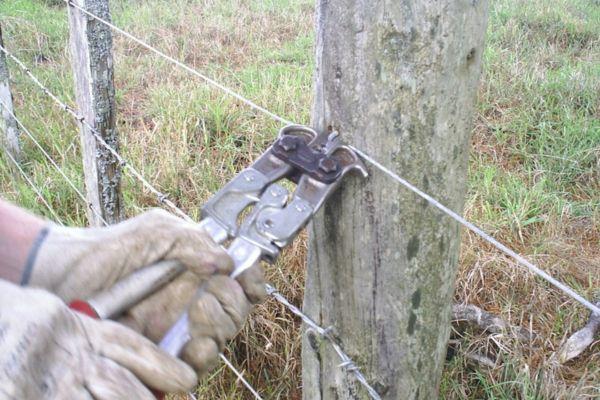
Fence Repair & Maintenance
Fences don't last forever, at some point they'll need fixing or replacing. Catch problems early and you can repair them (usually cheaply), leave things long enough and replacement will be your only practical option (always more expensive).
Regular maintenance extends the life of a fence. Over time wires get loose, they also slacken off/tighten up as temperature changes or the ground dries out and then gets wet again during the year. Staples come out, wires break, electric insulators break, livestock put pressure on a fence - it all takes its toll.
Autumn is usually the season to look at fencing maintenance. Start with a walk along all your fence lines. It's a good idea to do this at least twice a year if you can. Re-staple loose wires to posts when you see them - stock might escape, or grazing pressure can increase the damage even further. A good way to work your way around is to carry a large bucket with some basic fencing tools - fencing pliers, chain strainer, Ezepulls, crimps, permanent wire strainers, staples, insulators, etc - that way you can fix minor problems as you encounter them, and cart away any old staples and wire you take off the fence.
The decision on whether to repair or rebuild fence lines will depend on affordability. Generally speaking, completely replacing completely decrepit fences is usually less expensive than repairing them.
Repair, rebuild, or replace? If you want to save money by reusing old materials - will the savings you'll make in using recycled materials outweigh the possible increased labour costs to incorporate them in the rebuild? If you're getting a contractor to do the work it is often more expensive to re-use old materials than to use new - particularly wire. It's far quicker to run out wire off a new coil, tie it off and strain it up in one clean easy strain; than it is to fight with a tangle of old wire, join shorter lengths together, tie it off, strain it up, join it again where it breaks (as it invariably does), and clock up an extra hour of labour to re-use $15 worth of old wire …
If you are reusing some wires - use new wires for your top and bottom wires and older wires second from the bottom upward. Extra care needs to be taken straining up old wire - you should always wear safety goggles when working with wire, with old wire it's even more important to protect your eyes.

Re-tightening wires on a battened fence aren't easy - if the fence is in really poor condition it often involves stripping most or all battens off the wires to re-strain the fence, then rebattening it. If all the posts and strainers are sound and reasonably in line it can still be worth the extra effort - an old fence can be brought right up to standard and good for another 10 or more years.
Staples online posts should be angled to the wire - that way the two points of the staple will be held in separate grains of the post, and you'll reduce the chance of opening up a split in the posts.
Don't hit staples all the way in - leave them just clear of the wire - about 1mm.
The wire needs to be able to slide through the staple.
What to check for in a fence line:
Strainer posts - are they still solid, have they moved or lifted, have they rotated off the stay post?
Check post staples - pull a few out - staples rusting out is a common failure point on older fences. Replace them if you have to; try not to drive the new staple into the hole the old one came out of. Angle your staple on the wire - as per the photo above.
Check wire tension, especially on old fences - don't over-tighten wires - you could pull old strainer posts over. During hotter weather and any droughts resist the temptation to tighten up fences - posts will be loose in the ground and could lift if not properly footed, and wires will get even tighter when temperatures get colder. Wait until there's been some rain and posts aren't as loose.
Check footed posts (in low spots on the fence line) - are the foot wires still sound? If they've rusted through, consider driving another post, or hammering a steel Y-post into the ground next to the post as a foot and wiring the original post to it - with the foot wire above ground instead of buried.
Look for damaged or badly rusted wires, cut out the damaged section, and splice in new wire. Use crimp sleeves for joining old to the new wire - it's stronger than a knot, and it's safer for the person doing the joining too.
Straighten up and tighten battens. Replace any missing or broken battens.
"Before You Start Fencing" is a practical guide packed with a lifetime of experience, offering essential tips and advice to help you plan and manage fencing projects with confidence.

